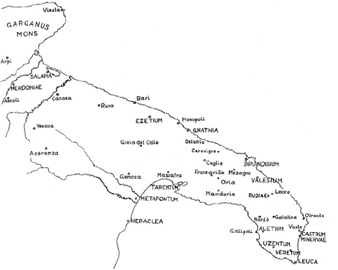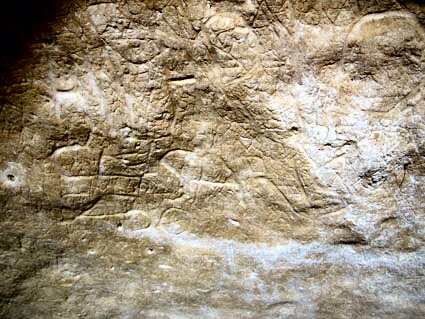The Region
 The
south-east of Italy has traditionally been divided into three
ethnic/cultural zones - Daunia, Peucetia and Messapia proper, which
corresponds to the Salento. These divisions derive largely from
the works of Greek and Roman authors, who variously (and confusingly)
identify the populations of the region as Apuli, Iapyges, Dauni, Peuceti,
Messapi and Sallentini - categories which frequently overlap and
contradict each other, and which come accompanied by Hellenocentric
origin and foundation myths. As a result, the ethnography of the
region must be treated with extreme caution.
The archaeology of the region
does support the idea that it may have contained several different -
although closely linked - cultural groups, but attempting to map the
ethnic identifications of the ancient sources onto these would be
extremely hazardous. Although there is good evidence from
inscriptions and coin legends for self-definition at the level of the
individual community, It is very unclear what the wider, ethnic,
self-definition of these groups was and how it developed.
The
south-east of Italy has traditionally been divided into three
ethnic/cultural zones - Daunia, Peucetia and Messapia proper, which
corresponds to the Salento. These divisions derive largely from
the works of Greek and Roman authors, who variously (and confusingly)
identify the populations of the region as Apuli, Iapyges, Dauni, Peuceti,
Messapi and Sallentini - categories which frequently overlap and
contradict each other, and which come accompanied by Hellenocentric
origin and foundation myths. As a result, the ethnography of the
region must be treated with extreme caution.
The archaeology of the region
does support the idea that it may have contained several different -
although closely linked - cultural groups, but attempting to map the
ethnic identifications of the ancient sources onto these would be
extremely hazardous. Although there is good evidence from
inscriptions and coin legends for self-definition at the level of the
individual community, It is very unclear what the wider, ethnic,
self-definition of these groups was and how it developed.
The language of the region - conventionally known as
Messapic - is found from the Tavoliere and Gargano regions in the north
down to the Salentine peninsular, and as far west as the Greek
settlement of Tarentum.
It is possible that variations within the region can be identified in
both the language and the alphabet in which it is written, but there is
no clear division into separate languages. Oscan inscriptions are
found in the north-west of the region, around Venosa and Canosa, and
Greek inscriptions are predominant in the territory of Tarentum.
Greek language and script is also found in other contexts, notably some
sanctuaries, and used by the Messapic communities for certain types of
inscription. Latin inscriptions appear from the 2nd century BC
onwards, but do not occur in significant quantity until the 1st century
AD.
The Inscriptions
 |
|
Inscriptions in cave
sanctuary, Rocavecchia |
The data for this region comprises c.700 Messapic
inscriptions, together with a number of Greek and Latin examples.
Greek and Latin inscriptions are included for comparative purposes,
where they interact with indigenous material, but are not the primary
focus of this study. There are also a small number of inscriptions
written in other languages and alphabets such as Oscan, and an isolated
example of Punic. The earliest Messapic inscriptions appear in the
6th century BC, but by far the largest number date to the 4th-2nd
centuries BC, with a particularly high concentration dating to the 3rd
century. Messapic continues to be used for funerary and monumental
inscriptions until the 1st century BC, but in much smaller
numbers. Many of the inscriptions from the region are
collected in existing corpora (Whatmough, Conway and Johnson
1933; Parlangeli 1960; Santoro 1983; Santoro 1984 and De Simone and
Marchesini 2002); it is not our
intention to try to replace these, but to create
a searchable resource from this - and more recent - data, and to examine
their socio-cultural significance.
The alphabet in which the inscriptions are written is
adapted from Greek and probably derived originally from Tarentum, but it
rapidly evolves to develop unique letter-forms of its own and shows a
high degree of chronological development, as well as developing regional
sub-divisions in the northern part of Puglia.
The majority of Messapic inscriptions are from votive
or funerary contexts and occur on tombstones (both from inside the tomb
and on cippi designed to mark the tomb above ground) and a variety of
votives. Most of the votives taken the form on dipinti or
inscriptions on potsherds and inscriptions on stone cippi, but there is
also a long-standing tradition of locating sanctuaries in caves along
the coast of the Salento, and the important cave sanctuary of Grotta
della Poesia (Leuca) has a large number of votive inscriptions carved on
the wall of the cave. There are also a large number of
inscriptions and graffiti on portable items, notably items such as loom
weights, which are connected with textile-production and wool-working -
staples of the local economy. One significant difference between
the inscriptions of Puglia and those of north-east Italy is the
gender-balance represented. Whereas in the Veneto, there are a
large number of inscriptions commemorating, or dedicated by, women, in
Puglia, the epigraphic record is overwhelmingly male. Most of the
funerary inscriptions commemorate men, apart from a group - the
so-called tabara inscriptions - which are believed to
commemorate priestesses, and many of the votives are also dedicated by
men
References
R.S. Conway, J. Whatmough and S. Johnson (1933), The
Prae-Italic Dialects of Italy. 3 vols.
Parlangèli, O. (1960). Studi Messapici
Santoro, C. (1983) Nuovi Studi Messapici. 2 vols.
Santoro, C. (1984) Nuovi Studi Messapici. Primo
supplemento.
De Simone, C. and Marchesini, S. (2002) Monumenta Linguae Messapicae.
2 vols.